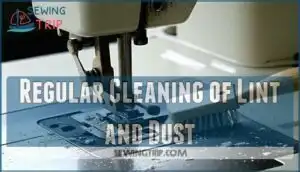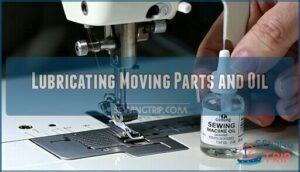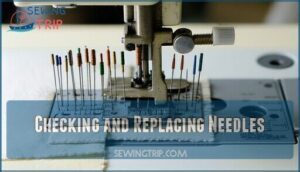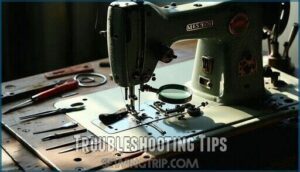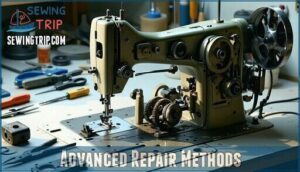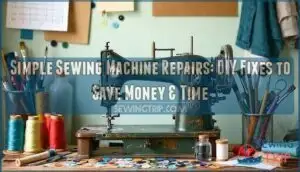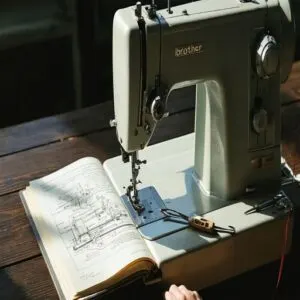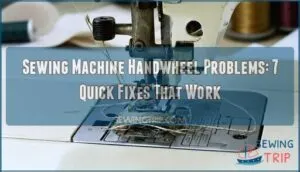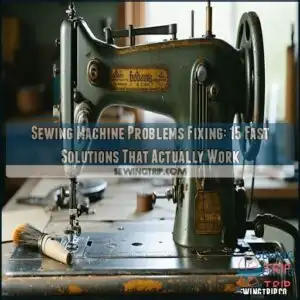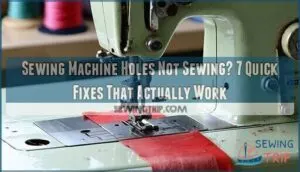This site is supported by our readers. We may earn a commission, at no cost to you, if you purchase through links.
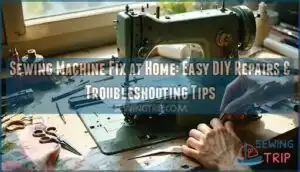 You can tackle most sewing machine problems right from your kitchen table with basic tools and patience.
You can tackle most sewing machine problems right from your kitchen table with basic tools and patience.
Start by cleaning out lint buildup, re-threading your machine properly, and checking needle condition – these simple steps solve about 80% of common issues.
Thread tension problems, fabric feeding troubles, and mysterious jams usually stem from dirt, incorrect threading, or worn needles.
Most repairs don’t require expensive service calls or specialized knowledge.
Your machine’s manual holds the roadmap to specific adjustments, while YouTube tutorials can walk you through trickier fixes.
With the right approach, that temperamental machine transforms from frustrating enemy to reliable workhorse, and the satisfaction of a successful sewing machine fix at home beats any store-bought solution.
Table Of Contents
Key Takeaways
- You’ll solve 80% of sewing machine problems with basic cleaning, proper re-threading, and needle replacement – most issues don’t need expensive repairs.
- Thread bunching, fabric feeding troubles, and machine jams typically stem from lint buildup, incorrect threading paths, or worn needles you can easily fix yourself.
- Regular maintenance like cleaning lint every few projects and oiling moving parts prevents 90% of common problems before they start.
- You can tackle advanced repairs like tension adjustments and part replacements using basic tools and your machine’s manual for guidance.
Common Sewing Issues
Your sewing machine will eventually hiccup, and when it does, you’ll face three main culprits that cause most home sewers to panic unnecessarily.
Thread bunching creates messy tangles under your fabric, needles break when you least expect it, and your machine jams at the worst possible moments—but these problems are easier to fix than you think, with complete concepts of troubleshooting being key to resolving them quickly, and understanding that they are easier to fix.
Thread Bunching and Breakage
Two major culprits cause thread bunching and breakage: threading problems and tension imbalance. When your machine creates "bird’s nests" underneath fabric, it’s screaming for help.
When your machine screams for help with thread tangles, listen carefully—proper diagnosis saves hours of frustration.
Threading Problems often stem from incorrect upper thread paths or dirty bobbin areas. Tension Imbalance between upper and lower threads creates chaos. Poor Needle Quality with bent or dull needles contributes to breakage. Fabric Compatibility issues arise when using wrong thread weights.
Sewing machine troubleshooting starts with complete re-threading—this fixes 90% of thread bunching issues. Clean your bobbin issues by removing lint buildup. Check thread tension settings and adjust gradually. Test on fabric scraps before continuing your project.
- Re-thread both upper thread and bobbin completely from scratch
- Clean lint and debris from bobbin case and threading paths
- Adjust tension dials one quarter-turn at a time while testing
- Match thread weight to needle size for proper fabric compatibility
Needle Breakage and Replacement
Needle breakage often signals deeper issues with your machine setup.
When needles snap unexpectedly, check for needle condition first—dull or bent needles can’t handle fabric thickness properly.
Needle types matter too: ballpoint for knits, universal for wovens.
Safety precautions include powering off before changes.
Proper insertion technique guarantees the flat side faces back, seated fully against the stopper.
Incorrect thread tension can also lead to frequent needle buckling.
Replace sewing machine needles every 8-10 hours to maintain sharpness and prevent needle issues.
Machine Jamming and Tension Issues
Machine jams happen when thread jams disrupt your workflow.
First, check for bobbin thread snags around the hook mechanism cleaning area.
Turn off your machine and remove tangled threads carefully.
Tension adjustment problems cause most jamming issues.
Your tension dial calibration might need tweaking, or presser foot pressure could be wrong.
Feed dog alignment also affects smooth operation.
For effective sewing machine troubleshooting:
- Frustration melts away when you master sewing machine tension basics
- Confidence builds as bobbin issues become manageable challenges
- Pride swells when your machine purrs smoothly after your repair
Basic Repair Techniques
Rolling up your sleeves for sewing machine repair doesn’t require a degree in engineering. With basic tools like screwdrivers, tweezers, and machine oil, you’ll tackle most problems head-on.
Start every repair by unplug machine – safety first. Remove the needle plate to access jammed threads, then adjust tension dials gradually while testing on fabric scraps. This DIY sewing machine fix approach prevents overcorrection.
Regular cleaning prevents 90% of issues. Use your lint brush after every few projects to remove buildup from feed dogs and bobbin areas. Lubricate parts with 1-2 drops of sewing machine oil on moving components – but don’t overdo it.
Needle replacement should happen every 8-10 sewing hours or when you notice skipped stitches. Match needle size to fabric weight for ideal results. To prevent thread issues, consider replacing needles regularly.
Master these sewing machine troubleshooting basics: proper threading, tension adjustment, and routine sewing machine maintenance. Most repairs become manageable when you understand these fundamentals. Remember, patience beats rushing – take your time diagnosing problems before attempting fixes.
Cleaning and Maintenance
Proper maintenance keeps your sewing machine running smoothly and prevents most common problems before they start.
You’ll save time and frustration by following a simple cleaning and lubrication routine that takes just a few minutes each week, which is a key part of proper maintenance.
Regular Cleaning of Lint and Dust
Lint removal tools like cleaning brushes or soft cloths work wonders for sewing machine cleaning. Clean your machine’s bobbin area, feed dogs, and needle plate regularly to prevent lint buildup.
Cleaning frequency matters – remove debris every few days if you’re sewing daily, monthly for occasional use.
This sewing machine maintenance prevents jamming and extends your machine’s life.
Dust prevention starts with consistent care, making interior cleaning and exterior cleaning simple routine tasks.
Lubricating Moving Parts and Oil
After cleaning away dust and debris, your machine needs proper sewing machine lubrication to run smoothly. Sewing machine oil acts like your machine’s lifeblood, preventing rust and reducing friction between moving parts.
As a result, regular oiling guarantees peak performance and longevity. Check your manual for specific Lubrication Points and Oil Types – only use genuine sewing machine oil, never household alternatives.
- Apply 1-2 drops at designated joints following your Oiling Frequency schedule
- Run a brief Post-Oiling Test to distribute lubricant evenly
- Practice Avoiding Over-Oiling to prevent fabric stains and dust attraction
Checking and Replacing Needles
After keeping your machine well-oiled, you’ll want to inspect your needles regularly. Bent needles cause skipped stitches and poor results.
Check for damage after every project or 8-10 hours of use. Needle breakage happens when you’re using wrong needle sizes for fabric or hitting pins.
Replace damaged needles immediately and match sewing machine needles to your material. Consider purchasing new needles for peak performance.
Store spares safely to prevent bending. Proper needle insertion guarantees smooth operation. Correct sewing needle types make all the difference—it’s like having the right tool for the job.
Troubleshooting Tips
When your sewing machine acts up, you don’t need to panic or rush to the repair shop just yet.
These troubleshooting steps can help you identify the problem and get back to sewing in no time.
Identifying and Fixing Thread Tension
Thread tension acts like the conductor of your sewing orchestra—when it’s off, everything sounds wrong! Check your upper tension dial first, then inspect bobbin tension for balance.
A balanced stitch is achieved when the upper and lower threads interlock perfectly in the fabric.
Here’s your tension troubleshooting checklist:
- Test tension adjustment on scrap fabric before sewing your project
- Clean tension discs to remove lint buildup that affects thread flow
- Check for fabric puckering—a sign your upper tension is too tight
- Look for skipped stitches which often indicate loose bobbin tension
- Adjust tension dials gradually, making small changes between tests
Resolving Fabric Feed Issues
When your fabric refuses to budge, you’ve got a feed system problem that’s easier to fix than you think. Start with feed dog adjustment—these metal teeth must rise at least 0.5mm above the needle plate to grip fabric properly.
- Check presser foot pressure settings and increase for thick or slippery materials
- Clean feed system cleaning areas under the needle plate where lint accumulates
- Verify feed dogs aren’t blocked by embroidery plates or debris
- Match fabric type selection with appropriate needle size to prevent fabric snags
- Make certain stitch length isn’t set to zero, which stops fabric not moving forward
Adjusting Bobbin and Thread Tension
Perfect tension adjustment starts with understanding your machine’s balance. Check your bobbin case tension by lifting the case with thread – it should drop slowly when jerked gently.
Master the gentle thread-drop test—your secret to perfect stitches every time.
For thread tension, turn tension dials gradually while testing on scrap fabric. Thread spool quality and fabric thickness impact both affect stitch appearance analysis.
Remember: 90% of thread jams disappear with proper tension dial calibration.
| Tension Issue | Quick Fix |
|---|---|
| Loops on top | Lower upper tension |
| Loops underneath | Raise upper tension |
| Thread breaks | Check bobbin tension |
| Puckered fabric | Balance both tensions |
| Skipped stitches | Clean thread tension discs |
Advanced Repair Methods
When basic troubleshooting doesn’t solve your sewing machine problems, you’ll need to step up to advanced repair techniques.
These methods involve re-threading your entire machine, adjusting complex tension settings, and potentially replacing worn parts using specialized tools.
Re-threading and Adjusting Tension Settings
Uneven stitches signal it’s time for tension troubleshooting. Start by completely rethreading your machine—follow the thread path exactly as shown in your manual.
Check your bobbin loading technique and verify proper seating. Adjust upper tension gradually while testing stitch quality on scrap fabric matching your fabric type.
Fine-tune tension settings until achieving balanced thread tension for professional results.
Inspecting and Replacing Machine Parts
Your sewing machine’s performance depends on healthy components working in harmony. Worn parts like damaged needles, loose gears, or wobbly bobbin cases signal trouble ahead.
Follow this inspection checklist:
- Check needle condition – Replace bent, dull, or damaged needles immediately
- Examine bobbin case – Look for cracks, gouges, or rough edges from thread jams
- Test gear alignment – Listen for grinding noises during operation
- Inspect belts – Check for cracks or stretching in drive belts
- Assess motor function – Note unusual sounds or irregular operation
Your sewing machine repair kit should include screwdrivers, tweezers, and replacement parts for quick fixes. Selecting the correct needle type is essential for fabric care. Always unplug before starting any sewing machine repair work. Proper sewing machine troubleshooting prevents costly breakdowns later.
Using Specialized Tools and Equipment
Quality precision screwdrivers with magnetic tips prevent losing tiny screws during disassembly.
Needle-nose pliers grip broken needle fragments in tight spaces, while fine tweezers handle delicate threading tasks.
Machine oilers with precision applicators guarantee proper lubrication without excess.
Complete repair kits include specialized tools for timing belt adjustments and bobbin case repairs.
Professional sewing machine repair tools transform complex fixes into manageable tasks, giving you confidence to tackle advanced maintenance.
For a range of options, consider magnetic tip sets for various screw sizes.
Frequently Asked Questions (FAQs)
What is the most common problem of the sewing machine?
Thread bunching is your machine’s most frequent headache, usually caused by incorrect threading or a dirty bobbin area. You’ll find that 90% of stitching problems disappear when you completely re-thread everything.
How to fix a sewing machine that is not working?
You’re not alone if your machine suddenly stopped working—most issues aren’t permanent breakdowns.
First, unplug the machine for safety, then rethread it completely since 90% of problems stem from improper threading, tension issues, or lint buildup.
Can I fix my own sewing machine?
Yes, you can tackle most basic sewing machine problems yourself. Simple fixes like rethreading, cleaning lint, changing needles, and adjusting tension solve about 90% of issues without professional help needed.
What to do with a sewing machine that doesn’t work?
First, unplug your machine and check for obvious problems like tangled thread or lint buildup.
Most issues stem from improper threading, dull needles, or tension problems that you can fix yourself.
Is it worth it to fix a sewing machine?
Don’t throw in the towel just yet!
Most sewing machine problems stem from simple issues like improper threading, dull needles, or lint buildup.
You can easily fix these at home with basic cleaning and re-threading, making repair worthwhile.
How to fix noisy sewing machine?
Clean and oil your machine regularly, check for loose screws or worn belts, and verify you’re using the correct needle size and thread tension for your fabric.
Fixing computerized sewing machine display issues?
Check your power connection first, then restart the machine by turning it off and on again.
If the display remains blank or shows error codes, consult your manual for specific troubleshooting steps.
Can I repair electrical cord damage?
Stop—that exposed wire you’re staring at could be a fire hazard waiting to happen.
You can repair minor electrical cord damage yourself using electrical tape or heat-shrink tubing, but major cuts or internal wire exposure require professional replacement for safety.
Repairing foot pedal responsiveness problems?
First, unplug your machine and examine the foot pedal cord for fraying or damage.
If the cord’s intact, open the pedal casing to check for loose connections, dust buildup, or worn carbon contacts that need cleaning or replacement.
How to recalibrate automatic buttonhole feature?
Nearly 80% of automatic buttonhole malfunctions stem from improper sensor calibration.
You’ll need to consult your manual for your model’s specific recalibration sequence, typically involving test fabric and resetting the buttonhole lever position.
Conclusion
Picture Sarah frantically trying to finish her daughter’s Halloween costume at 11 PM, only to have her machine start eating fabric like a hungry monster.
Mastering sewing machine fix at home techniques transforms these midnight disasters into minor speed bumps. You’ve learned that most problems stem from simple issues like lint buildup, incorrect threading, or dull needles.
Regular maintenance prevents expensive repair bills and keeps your creative projects flowing smoothly. With these troubleshooting skills in your toolkit, you’ll handle future machine hiccups with confidence and get back to creating beautiful pieces.
- https://topnotchsewvac.com/blogs/sewing-machine-blog/top-10-essential-tips-for-diy-repair-for-sewing-machine-problems
- https://pubs.nmsu.edu/_c/C202/index.html
- https://www.diaryofaquilter.com/how-to-clean-your-sewing-machine/
- https://so-sew-easy.com/common-sewing-machine-problems/
- https://wunderlabel.com/en-gb/blog/p/17-common-sewing-machine-problems-solve/

